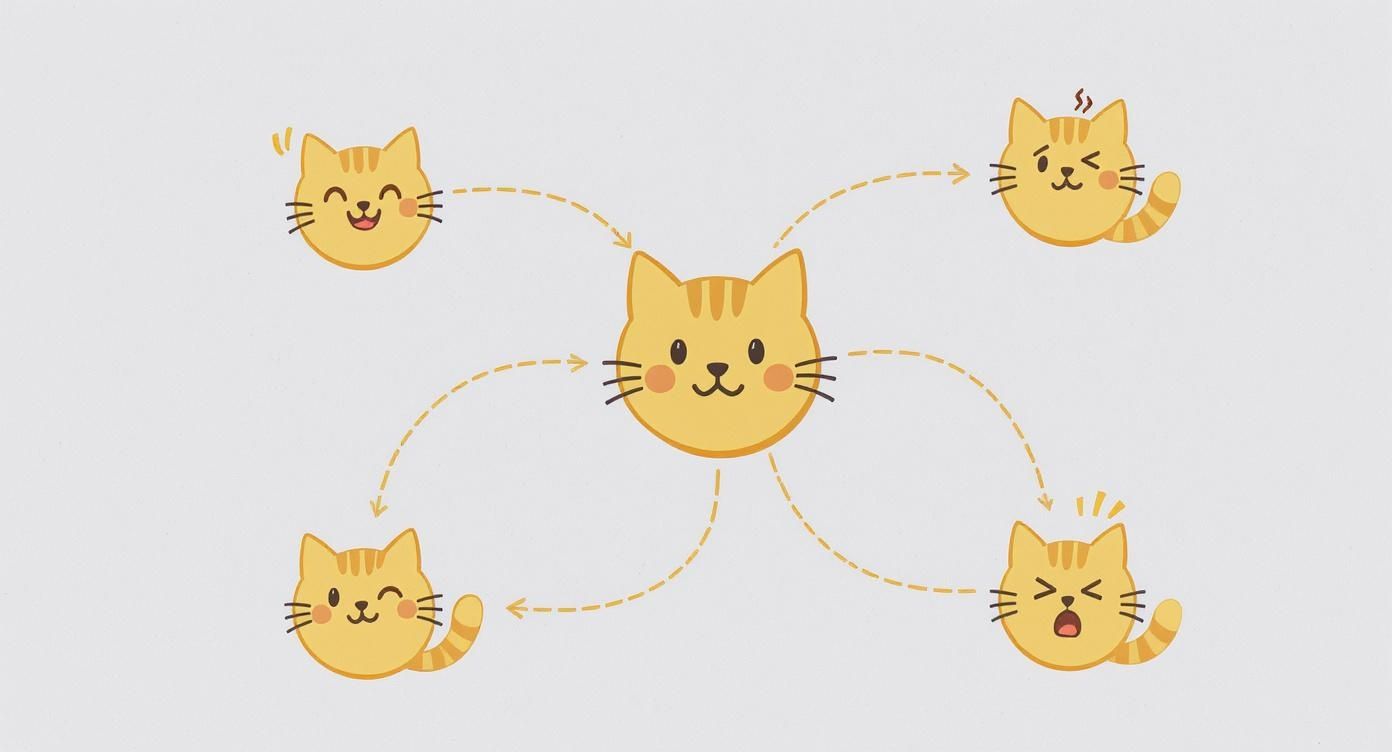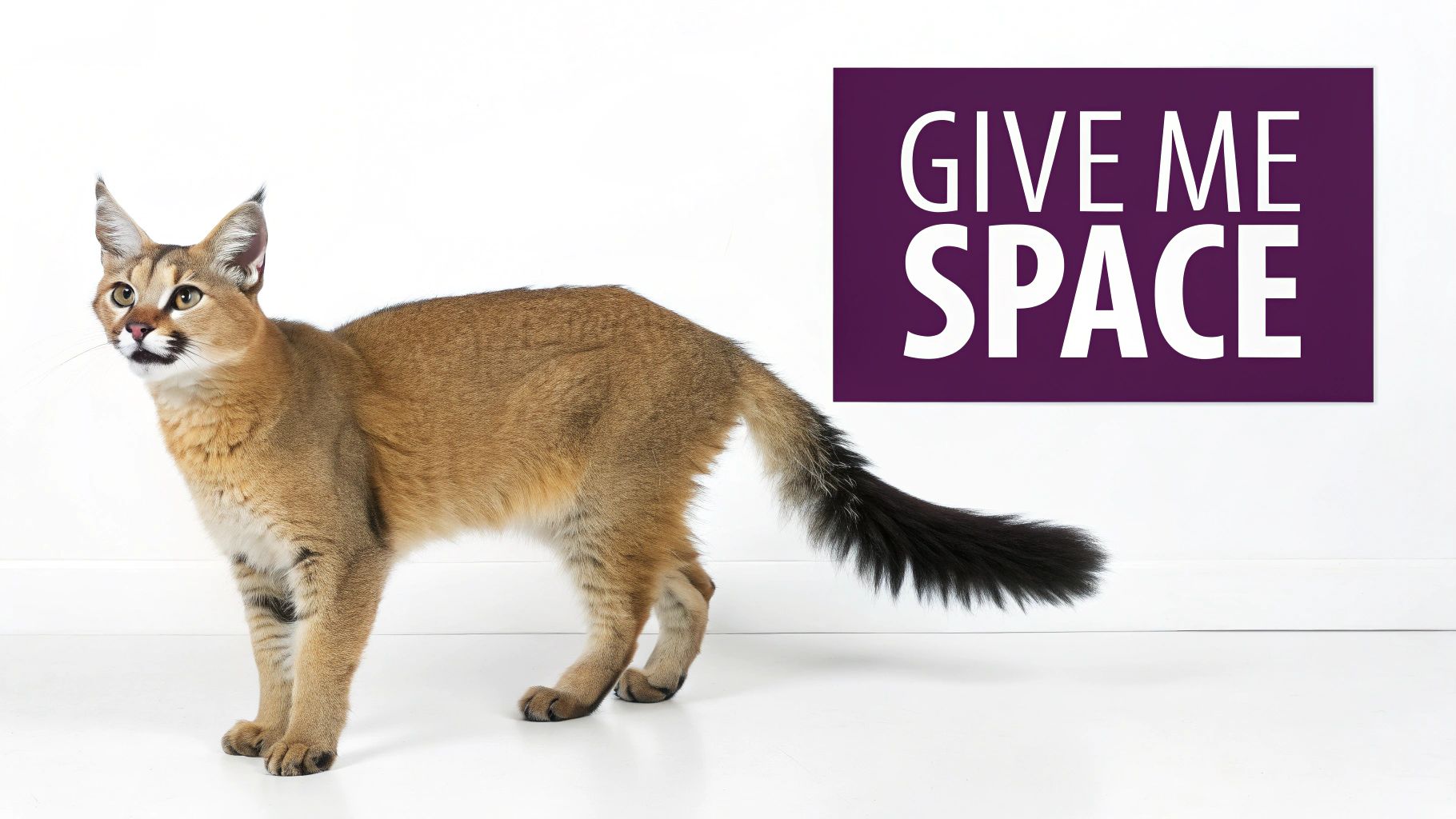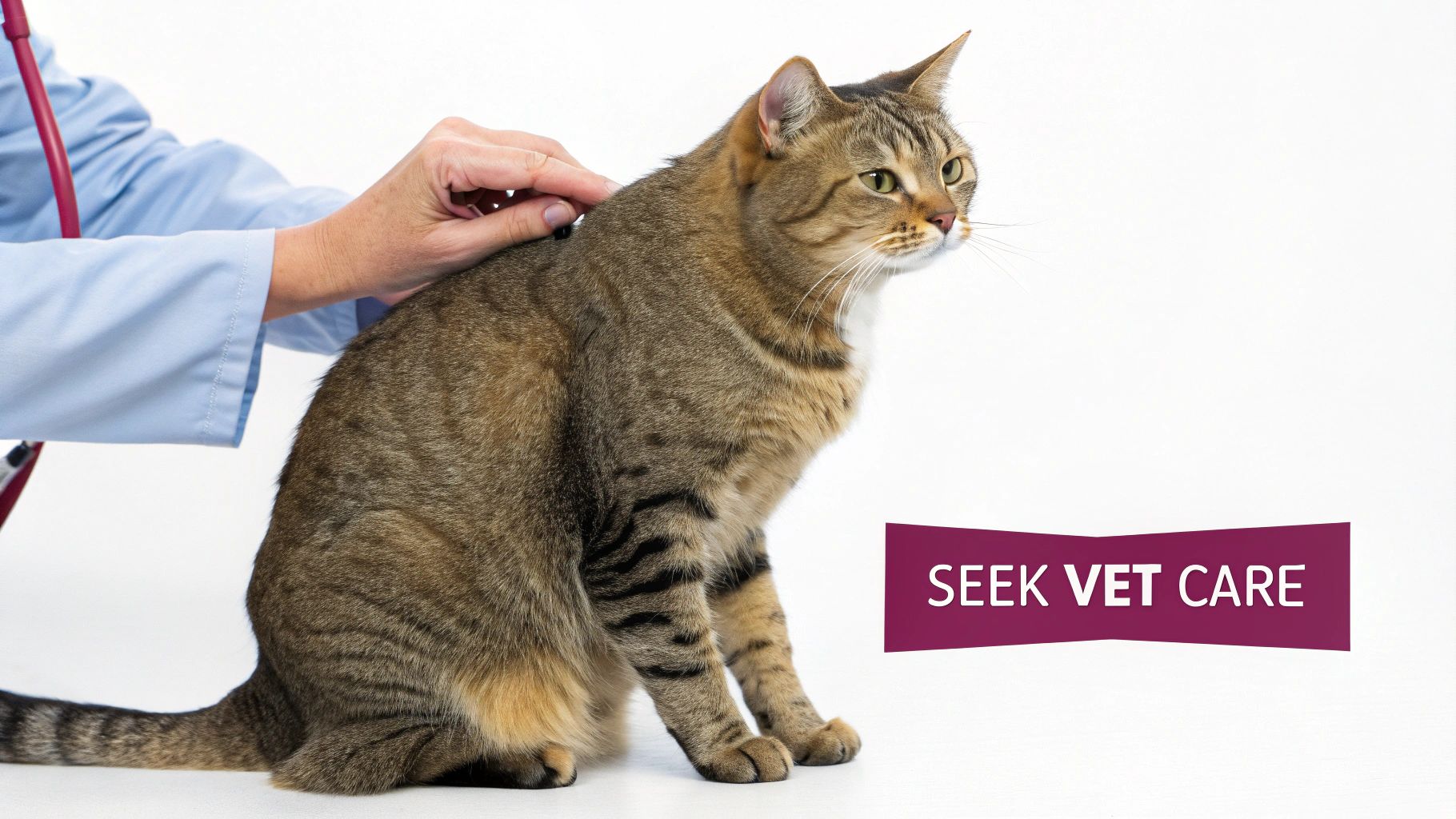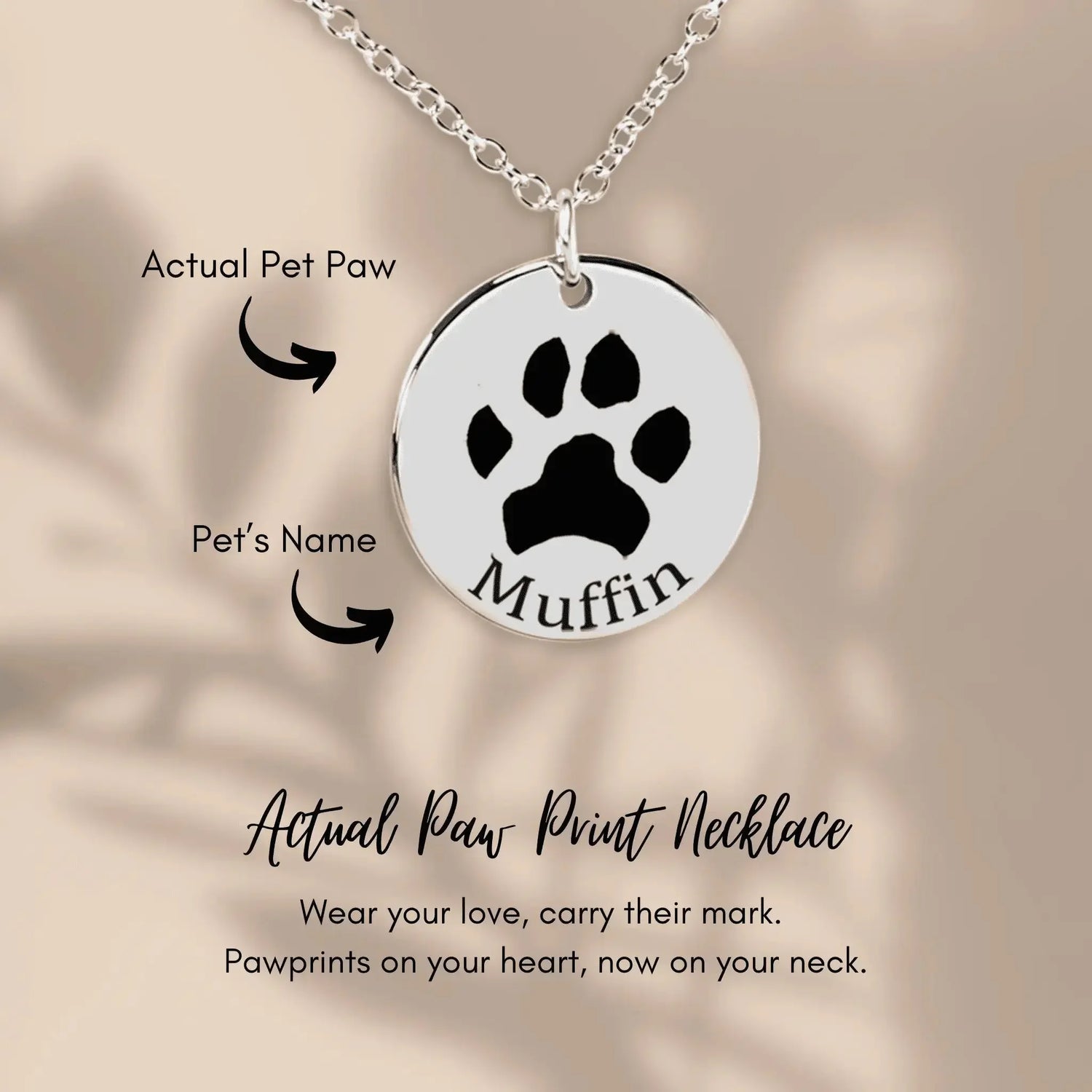What Do Cat Tail Positions Mean A Purrfect Guide

Have you ever looked at your cat and just wondered what's going on in that furry little head? 🤔 Well, a big clue is right there in their tail. A cat’s tail is so much more than just an appendage; it’s a furry, expressive antenna broadcasting their every mood, from pure, unadulterated joy to serious irritation.
Understanding these signals is one of the fastest ways to build a stronger, more intuitive bond with your cat.
Your Guide to Cat Tail Language
Welcome to your official decoder ring for all things feline! Think of this as your secret translator for every flick, twitch, and swish. Our fluffy mascot, Floofie, is here to help us make sense of it all. Just like people use facial expressions and body language to show how they feel, cats use their tails to put their emotions on full display. 😺
Learning to read this language is like unlocking a new level in your relationship with your cat. It helps you know when they're craving a cuddle, when they'd rather be left alone, and when they're feeling feisty and ready to play. Getting this right prevents misunderstandings—like trying to pet a cat who's clearly agitated—and deepens the trust between you. After all, a happy kitty makes a happy home!
Quick Guide to Cat Tail Position Meanings
For those moments when you need a quick translation, this handy table breaks down the most common tail positions and what they likely mean.
| Tail Position | What It Looks Like | Most Likely Meaning 😻 |
|---|---|---|
| Held High & Upright | Straight up, often with a slight curve at the tip. | Happy, confident, friendly. |
| Puffed Up (Halloween Cat) | Bristled and bushy, like a pipe cleaner. | Frightened or very angry; trying to look bigger. |
| Tucked Under or Between Legs | Pulled in tightly against the body. | Scared, anxious, or submissive. |
| Slow, Gentle Swish | A slow, lazy wave from side to side. | Curious, focused, or assessing a situation. |
| Lashing or Thumping | Fast, sharp, and forceful movements. | Agitated, irritated, or angry. "Back off!" |
| Wrapped Around Body/Paws | Curled neatly around themselves while sitting or lying down. | Relaxed, content, but may want some space. |
| Quivering or Vibrating | A quick, slight trembling motion. | Excited and happy to see you! |
| Question Mark (?) Tail | Held high with a distinct curve at the tip. | Playful, curious, and feeling friendly. |
This is just a starting point, of course! Context is everything, so always look at what else is going on around your cat.
Why Tail Language Matters
Paying attention to your cat's tail isn't just a fun party trick; it's one of the most fundamental ways you can respect their feelings and needs. Think of it as a direct line to their emotional state.
- Building Trust: When you respond correctly to their tail signals, you're telling them, "I see you, and I understand you." That validation builds an incredible bond.
- Preventing Scratches: Recognizing an irritated, lashing tail can save you from a painful swipe. It’s their polite (and then not-so-polite) way of saying "please stop."
- Providing Comfort: Spotting a tucked, fearful tail lets you know that something has spooked your cat, and they need you to create a safe space or offer gentle reassurance.
This handy visual breaks down the core emotions tied to the most common tail positions.

As you can see, a tail held high is usually a green light for happy interactions, while a low, tucked, or puffed-up tail is a major red flag for fear or aggression. Appreciating all the little things that make your cat unique is what being a pet parent is all about. If you're looking for another way to celebrate their one-of-a-kind personality, you might even look into finding the perfect cat portrait artist to capture their spirit forever.
Now, let’s dive into the specifics of each tail position! 🐾
Happy and Content Cat Tail Signals
Alright, let's get into the good stuff—the tail signals that make our hearts melt. 💖 These are the clear signs that say, "Life is good, my human is great, and I am one happy, confident cat." Learning to spot these positive vibes is one of the best parts of being a cat owner.
The most iconic happy-cat signal is the upright tail, held high and proud as your cat patrols their kingdom. Think of it as the feline equivalent of a big, cheerful wave. When that tail is pointing straight to the ceiling, your cat is feeling fantastic, sociable, and completely at ease in their environment.
The Adorable Question Mark Tail
Ever see your cat walking toward you with their tail held high, but with a charming little hook at the tip? 😻 That’s the famous question mark tail! This isn't just a happy signal; it’s a sign of pure joy and playful curiosity. It’s their way of asking, “Hi! So glad to see you! What fun are we getting into next?”
Our own Floofie does this every single time he hears the treat bag rustle or catches a glimpse of his favorite Wand Teaser Toy. It’s a totally unmistakable invitation for fun and attention. When you see it, reward them with a play session or a good chin scratch to show them you speak their language.
Key Insight: A high tail is a cat's go-to signal for social confidence and friendliness. They use it to greet people and other friendly cats, showing they feel secure and happy in their territory.
Slow Swishes and Cozy Wraps
Not all happy signals are big and bouncy. Sometimes, contentment is quiet. A slow, gentle swish of the tail from side to side, especially while your cat is dozing in a sunbeam or chilling on your lap, is a sign of deep relaxation. This isn't the angry, fast lashing we'll get to later; this is a lazy, peaceful movement that says, “All is well in my world.”
In the same vein, a trusting cat often shows affection by wrapping their tail around you. If you’re sitting on the couch and your cat’s tail gently curls around your arm, leg, or even your neck, take it as a furry hug! It’s a gesture of profound affection and a strong bond, showing they see you as a source of ultimate comfort and safety.
This kind of trust often goes hand-in-hand with other cute behaviors. For more on that, you should check out our guide on why do cats show their belly—another ultimate sign of feline love and trust.
Anxious or Fearful Cat Tail Positions
While we all live for those happy, upright tail greetings, it's just as crucial to understand what your cat's tail is telling you when they're feeling scared or anxious. Recognizing these more subtle cues is a huge part of being a responsible cat parent, allowing you to step in and offer comfort right when they need it most. 😟

Unlike the bold, confident tail of a happy cat, a fearful kitty will instinctually try to make themselves smaller and less threatening. Their tail language shifts dramatically to broadcast submission, uncertainty, and straight-up fear. These are the signals that say, “I’m really scared right now, please don’t hurt me.”
The Low-Slung and Tucked Tail
One of the most classic signs of a nervous cat is a tail held low to the ground. This posture screams fear or uncertainty. Think about when the terrifying vacuum cleaner roars to life or a stranger walks through the door—your cat’s tail might drop immediately as they size up the potential danger. It's their way of staying on high alert.
When that fear really ramps up, a low tail becomes a full tuck, pulled tightly between their back legs and flat against their body. This is the ultimate sign of submission and fright. Our mascot Floofie might do this during a stressful car ride to the vet. It’s a cat's attempt to become invisible, protecting their vulnerable belly while signaling they are absolutely not a threat.
A Note from Floofie: “When my tail is tucked, I’m feeling super scared! 😿 I’m not being grumpy; I just need a safe, quiet space to calm down. A little patience and a gentle voice go a long way to help me feel brave again!”
How to Help Your Frightened Feline
It’s tough seeing your cat in distress, but learning to read their tail is the first step toward helping them feel safe again. When you spot a low or tucked tail, your mission is to reduce whatever is causing the stress and create a sense of security. Never, ever force interaction with a scared cat—it will only make their fear worse.
Instead, try these simple, calming actions:
- Provide a Safe Haven: Make sure your cat has an easy escape route to a secure hiding spot. A cozy Cat Cave Bed is the purrfect retreat where they can feel protected from the big, scary world.
- Remove the Threat: If you can, get rid of the source of their fear. That could mean turning off the loud appliance, closing the blinds to hide the stray cat outside, or asking guests to give your kitty some space.
- Stay Calm: Your cat is a master at reading your energy. Speak in a soft, reassuring voice and avoid making any sudden movements.
Knowing how to soothe your furry friend is a key skill for any cat owner. For a deeper dive into creating a peaceful home, check out our guide on how to reduce cat anxiety for more expert tips and tricks.
Aggressive and Agitated Tail Warnings
Alright, let's get into the serious stuff—the "do not disturb" signs of the cat world. Cats are masters of subtlety, but when they're upset, their tails can be screamingly obvious. Recognizing these warnings is crucial for keeping the peace and avoiding a sudden swat or bite. 😠
Think of these tail positions as your cat's final, polite-but-firm request to back off. They're telling you, "I'm not happy, and I'm about five seconds from turning this into a real situation." Ignoring these signals is like trying to take Floofie's favorite crinkle toy mid-pounce—you’re just asking for trouble.
The Dramatic Bottle Brush Tail
There's no mistaking this one. The puffed-up tail, better known as the "bottle brush" or "Halloween cat" look, is the universal sign of a cat who is either terrified or seriously ticked off. Every single hair stands on end, making their tail look two or three times its normal size. It's a classic defense mechanism designed to make them look bigger and more intimidating to whatever threat just appeared—whether that's the neighbor's dog or a rogue vacuum cleaner.
This dramatic display is usually accompanied by a hissy fit and an arched back for full effect. It’s all about bluffing their way out of a scary encounter.
A Quick Tip from Floofie: “If my tail suddenly resembles a giant feather duster, it is not the time for cuddles! 🙅♀️ Just give me some space to process the scary thing and let my fabulous floof deflate on its own.”
When you see the bottle brush, your job is simple: identify and remove the stressor if you can. Don't rush in to comfort them by picking them up, as this can make them feel trapped and trigger a defensive scratch. The best thing you can do is give them a clear escape route.
Lashing Thumps and Annoyed Whips
Another big red flag is a tail that's lashing or thumping against the floor. This isn't a happy dog wag; for a cat, fast, sharp, whip-like movements are a clear sign of mounting irritation. You'll often see this when a petting session has gone on a little too long for their liking, or when another pet is getting all up in their personal space.
- Fast Lashing: A tail whipping quickly from side to side means your cat is highly agitated and overstimulated. They're on the verge of lashing out.
- Loud Thumping: If your cat is lying down but repeatedly thumping their tail hard against the floor or furniture, they are profoundly annoyed. This is the last warning you're going to get before things get spicy.
The moment you notice these sharp, angry movements, stop what you're doing. A great way to de-escalate is to redirect that frustrated energy. Try tossing one of our super fun UFO Interactive Cat Toys a safe distance away. It can shift their focus from annoyance to play, giving them a healthy way to blow off some steam.
Subtle Twitches, Quivers, and Wraps
Not every tail signal is a giant, dramatic statement like the classic puffed-up bottle brush. A lot of what your cat is trying to tell you is hidden in the smaller, quieter movements. Think of these subtle signals as the whispers of cat communication—just as important, but you have to lean in a little closer. 🧐
These tiny twitches and gentle wraps open up a whole world of feline focus, excitement, and deep affection. Our mascot Floofie is a master of these delicate gestures, especially when he's plotting his next pounce or feeling extra cuddly. Let's decode these tiny tail tales!

The Twitch of Total Concentration
Ever seen your cat staring intently out the window at a bird, with just the very tip of their tail doing a tiny, almost invisible twitch? That's not annoyance—it's a sign of deep concentration and focus. It’s like a little engine revving up in their brain as they lock onto a target, whether it’s a squirrel outside or their favorite Crinkle Fish Toy across the room.
This focused twitch is often the final tell right before they pounce! It’s the physical manifestation of their predator instincts kicking into high gear, showing that their mind is completely absorbed in the hunt. When you see this, it’s the perfect time to bust out a wand toy and give them a great play session.
The Quiver of Pure Excitement
One of the most heartwarming tail signals has to be the quiver. This isn't a big, aggressive shake but a fast, high-frequency vibration of their entire upright tail. It almost looks like they’re buzzing with happiness! 💓
You’ll usually catch this when you walk in the door after being out, or right when you’re about to scoop their dinner into the bowl. It's a pure, unfiltered expression of excitement and happy anticipation. Floofie does his signature tail quiver every single time we grab the Laser Pointer Toy—it’s his way of shouting, “Yes! It’s happening!”
A Little Secret: This excited quiver is one of the clearest signs of affection a cat can give. It's an unfiltered burst of joy directed right at you. Soak it up!
The Loving Tail Wrap
Finally, we have the ultimate gesture of feline friendship: the tail wrap. When a cat winds their tail around your leg, arm, or even another kitty, it's their version of a warm, furry hug. This is a sign of a powerful bond built on trust and companionship.
It's a deliberate act of connection, showing they consider you part of their inner circle. They're marking you with their scent and physically linking themselves to you. To encourage this beautiful behavior, make your shared moments extra cozy and secure. A soft, comfy spot with a Personalized Cat Blanket can create the perfect vibe for bonding. This simple, loving gesture truly speaks volumes.
When a Tail Signals a Health Problem
Of course, cat tails aren't always just broadcasting their latest mood swing. Sometimes, a tail can send a much more urgent message, letting you know that something is physically wrong. Paying close attention to your cat's tail is one of the best ways to catch a health issue early. It's not just about feelings; it's about their physical well-being! 🩺
A healthy, happy tail is usually mobile and expressive. But if you suddenly notice a constantly limp or drooping tail that never seems to lift, that’s a major red flag. This could point to anything from a simple sprain to a much more serious nerve injury or even a fracture, especially if your cat recently took a tumble. If your normally perky kitty is dragging their tail, it’s time to investigate.
Spotting the Warning Signs
Another big clue is a sudden change in their grooming habits. Is your cat obsessively licking or chewing their tail? This is often a sign of irritation from fleas, a skin allergy, or even a hidden abscess from a bite wound that’s bothering them. It's not just about what you can see on the surface; things like the different ringworm causes for cats can lead to discomfort that shows up in their behavior.
A Note from Floofie: “If I’m not feeling my best, my tail might give it away before I do! 🤒 Please don’t play vet at home, though. A quick call to my favorite doctor is the best way to keep me healthy, happy, and ready for cuddles.”
Your job isn't to diagnose the problem, but to be a sharp-eyed observer. Keeping our furry friends like Floofie safe is priority number one. If you notice any of the following signs, it's definitely time to give your vet a call for advice:
- A tail that is always held low, tucked, or completely limp.
- Excessive licking, chewing, or biting at the tail or the area around its base.
- Any visible wounds, swelling, or bald patches on the tail.
- Your cat hisses, cries out, or gets aggressive when you gently touch their tail.
Acting quickly can make a huge difference in getting your little buddy the help they need, right meow! A cozy Personalized Cat Blanket can give them a soft, safe spot to rest and recover.
Common Questions About Cat Tail Positions

Still have a few questions about what your cat's tail is trying to tell you? You're definitely not alone! Even those of us who have lived with cats our whole lives still find ourselves wondering about the finer points of feline body language. Let's tackle some of the most common questions, Floofie-style! 🐾
A big one we hear all the time is: Why does my cat wrap its tail around my legs? Think of this as the ultimate furry hug. 🤗 It’s a huge sign of affection and trust, their way of marking you as part of their inner circle. They’re literally connecting with you.
Another is about those funny little sleep twitches. If you spot your cat's tail twitching away while they’re snoozing, it’s a good bet they're dreaming—probably about finally catching that elusive red dot or pouncing on their favorite feather wand. It's just a sign of deep, active sleep and sweet kitty dreams. 💤
Dog Wags vs. Cat Wags
Here’s a classic point of confusion: Isn't a cat wagging its tail the same as a dog? Nope! 🙅♀️ And this is probably one of the biggest mix-ups between the two species. Getting this one right is key to a happy pet household.
- A Dog's Wag: This is usually a green light. It means happiness, excitement, and a friendly, open attitude. It’s a clear "come say hi!" signal.
- A Cat's Wag: This is more of a yellow or red light. A slow, gentle swish might just be them concentrating, but a fast, lashing wag is a clear sign of irritation. It’s a definite "back off!" warning.
Floofie’s Final Tip: “My tail tells my whole story, from happy little quivers to big, annoyed thumps. If you really want to be my best friend, learning my tail-talk is the best way to understand how I'm feeling!”
Paying attention to these little details is how you truly get to know your cat’s personality. It helps you respond to their needs more accurately, which is the secret to building an amazing, trusting bond that will last a lifetime.
Here at FloofChonk, we celebrate every little quirk and flutter that makes your cat special. To thank your kitty for being such a great communicator, why not treat them to something from our collection of irresistible toys and cozy accessories? Check them out at https://www.floofchonk.com.

